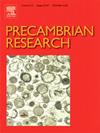上埃迪卡拉统微生物白云岩沉积模式演化及其古环境意义
IF 3.2
2区 地球科学
Q2 GEOSCIENCES, MULTIDISCIPLINARY
引用次数: 0
摘要
四川盆地上埃迪卡拉统灯影组(约551.1 ~ 542.0 Ma)广泛发育微生物白云岩。然而,这些微生物白云岩经历了复杂的沉积过程,其沉积环境仍存在争议。本文系统分析了上埃迪卡拉统灯影组微生物白云岩的岩石学、矿物学和地球化学特征。上埃迪卡拉统灯影组微生物白云岩(叠层石、血栓石、球状白云岩、壶状白云岩)表明了浅层限制台地微生物活动与环境条件的相互作用。微生物结构多样性反映了水动力-微生物的协同作用:叠层石和硼状白云岩形成于低能、高活性的环境中;分散的血栓形成在微弱的微生物影响下;层状/网状血栓和癌状体是在高能环境下通过粒子聚集形成的。两次海侵—海退旋回与“白云岩海”事件相关:第一次是由全球气候(蒸发、局部缺氧)驱动的,第二次是由构造隆升(铜湾运动I)驱动的,突出了构造在储层成因中的作用。地球化学指标反映冰期后海水分层和风化变化,限制了埃迪卡拉-寒武纪生物复杂性的环境触发因素。全球对比显示埃迪卡拉纪微生物成岩作用广泛,但四川盆地表现出独特的构造-气候旋回性。尽管成岩作用模糊了一些地球化学信号,但系统分析证实,灯影组是前寒武纪碳酸盐工厂演化、微生物-环境反馈和早期储层动力学的重要档案。该研究促进了对晚前寒武纪地球系统、桥接微生物过程、海水化学和构造气候对碳酸盐保存的控制的认识。本文章由计算机程序翻译,如有差异,请以英文原文为准。
Sedimentary model evolution and palaeoenvironmental significance of the Upper Ediacaran microbial dolomites
Microbial dolomites are extensively developed in the upper Ediacaran Dengying Formation (ca 551.1 to 542.0 Ma) in the Sichuan Basin, China. However, these microbial dolomites underwent complex depositional processes, and their sedimentary environments remain debated. In this study, the petrographic, mineralogical, and geochemical characteristics of microbial dolomites in the upper Ediacaran Dengying Formation are systematically analyzed. The microbial dolomites (stromatolites, thrombolites, oncoids, botryoidal dolomites) in the upper Ediacaran Dengying Formation demonstrate the interplay between microbial activity and environmental conditions in a shallow restricted platform. Microbial structural diversity reflects hydrodynamic-microbial synergy: stromatolites and botryoidal dolomites are formed in low-energy, high-activity settings; dispersed thrombolites are formed under weak microbial influence; layered/reticular thrombolites and oncoids are developed via particle aggregation in high-energy environments. Two transgressive–regressive cycles correlate with “dolomite sea” events: the first driven by global climate (evaporation, localized anoxia), the second by tectonic uplift (Tongwan Movement I), underscoring tectonics’ role in reservoir genesis. Geochemical indicators reflect post-glacial seawater stratification and weathering shifts, constraining environmental triggers for Ediacaran-Cambrian biotic complexity. Global comparisons reveal widespread microbial diagenesis during the Ediacaran, yet the Sichuan Basin exhibits unique tectono-climatic cyclicity. Although diagenesis obscures some geochemical signals, systematic analysis confirms the Dengying Formation as a critical archive for Precambrian carbonate factory evolution, microbial-environmental feedbacks, and early reservoir dynamics. This study advances understanding of late Precambrian Earth systems, bridging microbial processes, seawater chemistry, and tectono-climatic controls on carbonate preservation.
求助全文
通过发布文献求助,成功后即可免费获取论文全文。
去求助
来源期刊

Precambrian Research
地学-地球科学综合
CiteScore
7.20
自引率
28.90%
发文量
325
审稿时长
12 months
期刊介绍:
Precambrian Research publishes studies on all aspects of the early stages of the composition, structure and evolution of the Earth and its planetary neighbours. With a focus on process-oriented and comparative studies, it covers, but is not restricted to, subjects such as:
(1) Chemical, biological, biochemical and cosmochemical evolution; the origin of life; the evolution of the oceans and atmosphere; the early fossil record; palaeobiology;
(2) Geochronology and isotope and elemental geochemistry;
(3) Precambrian mineral deposits;
(4) Geophysical aspects of the early Earth and Precambrian terrains;
(5) Nature, formation and evolution of the Precambrian lithosphere and mantle including magmatic, depositional, metamorphic and tectonic processes.
In addition, the editors particularly welcome integrated process-oriented studies that involve a combination of the above fields and comparative studies that demonstrate the effect of Precambrian evolution on Phanerozoic earth system processes.
Regional and localised studies of Precambrian phenomena are considered appropriate only when the detail and quality allow illustration of a wider process, or when significant gaps in basic knowledge of a particular area can be filled.
 求助内容:
求助内容: 应助结果提醒方式:
应助结果提醒方式:


